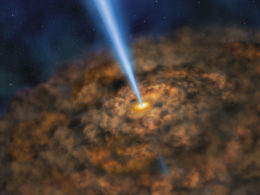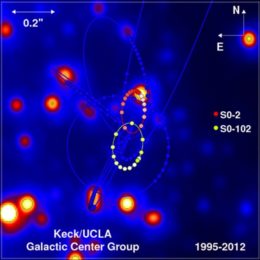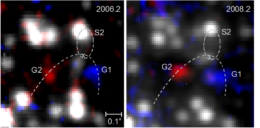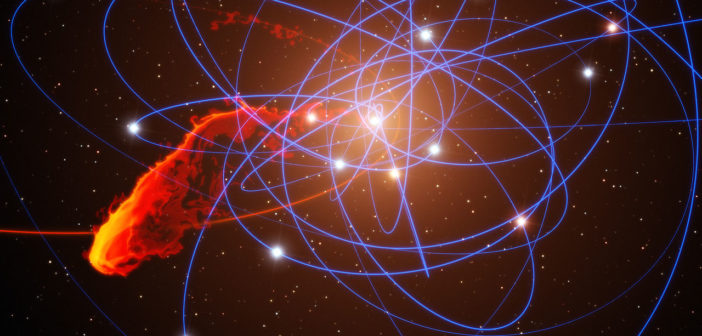In 2019, the supermassive black hole at the center of our galaxy woke up and emitted a series of burps. A new study now examines what meal may have led to this indigestion.

Artist’s impression of the dramatic outflows from an active galaxy’s nucleus. The Milky Way’s supermassive black hole, in contrast, is very quiet. [NASA/SOFIA/Lynette Cook]
Waking Up for a Snack
Sgr A*, the 4.6-million-solar-mass black hole that lies at the center of the Milky Way, is normally a fairly quiet beast. The black hole slowly feeds on accreting material in the galactic center — but this food source is sparse, and Sgr A*’s accretion doesn’t produce anything like the fireworks we associate with supermassive black holes in active galaxies.
In May 2019, however, Sgr A* suddenly became substantially more active than usual, producing an unprecedented bright, near-infrared flare that lasted roughly 2.5 hours. This flare was more than 100 times brighter than the typical emission from Sgr A*’s casual accretion, and more than twice as bright as the brightest flare we’ve ever measured from our neighborhood monster.
The May 2019 flare marked the start of prolonged increased activity — an unusual number of strong flares that continued at least throughout 2019 (currently analyzed data extends only to the end of that year). What caused Sgr A* to wake up? And do we expect more flaring ahead? A new study by Lena Murchikova (Institute for Advanced Study) explores the options.
Shedding Sources

Reconstruction of the orbits of several S stars at the center of the galaxy. The two colored orbits mark two stars with the closest known approaches to Sgr A*. [Keck/UCLA Galactic Center Group]
- Shedding S stars
The dense nucleus of our galaxy hosts a population of stars on tight orbits around Sgr A*. These stars shed mass via stellar winds, and when the stars swing close around Sgr A* at the pericenter of their orbit, this shed mass could accrete onto Sgr A*. - Disintegrating G objects
Also known to orbit close to Sgr A* are so-called G objects. These extended sources may be gas clouds, stars, or a combination of the two — we’re not sure yet! Tenuous G objects lose mass as a result of friction as they orbit, exhibiting higher rates of mass loss as they get closer to Sgr A* and are stretched out into shapes with large surfaces areas passing through dense background material. The mass they lose through this disintegration at pericenter could then accrete onto Sgr A*.

The objects G2 (colored red) and G1 (colored blue) and the star S2 are visible in these high-resolution images of the galactic center, taken in 2006 (left) and in 2008 (right). The position of Sgr A* is marked with an X. [MPE/Very Large Telescope]
Short-Lived or Long-Term?
Through a series of calculations, Murchikova estimates how much material is shed by these two types of objects and how long it would take that material to accrete onto Sgr A*. Based on the available observations, the author finds that the most likely explanation for our black hole’s unexpected rumblings in 2019 is currently accreting material from the combined past pericenter passages of the objects G1 and G2.
If this interpretation is correct, we would expect to see flaring continue for a limited time, but Sgr A* should then return to its quiescent state. If the flaring was instead a part of normal variability in the flow of accreting material onto Sgr A*, we would expect the activity to continue for years to come. Continued observations of this rumbling giant will tell!
Citation
“S0-2 Star, G1- and G2-objects, and Flaring Activity of the Milky Way’s Galactic Center Black Hole in 2019,” Lena Murchikova 2021 ApJL 910 L1. doi:10.3847/2041-8213/abeb70

6 Comments
Pingback: Rozbłyski z supermasywnej czarnej dziury w Drodze Mlecznej – PTMA Kraków
Pingback: Rozbłyski z supermasywnej czarnej dziury w Drodze Mlecznej – Astronomia Śląska
Pingback: Flares from the Milky Way’s Supermassive Black Hole - Sky & Telescope - Night Vision Now
Pingback: Flares from the Milky Way’s Supermassive Black Hole – Sky & Telescope – §Framework Info§
Pingback: Flares from the Milky Way’s Supermassive Black Hole - Sky & Telescope - Space Force
Pingback: A ÚLITMA REFEIÇÃO DO BURACO NEGRO DA VIA LÁCTEA - Globo online